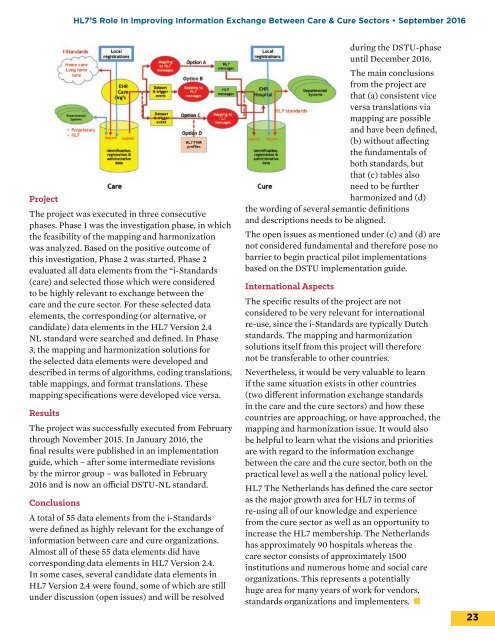In this Issue HL7 News
2cndmS4
2cndmS4
Create successful ePaper yourself
Turn your PDF publications into a flip-book with our unique Google optimized e-Paper software.
<strong>HL7</strong>’S Role <strong>In</strong> Improving <strong>In</strong>formation Exchange Between Care & Cure Sectors • September 2016<br />
Project<br />
The project was executed in three consecutive<br />
phases. Phase 1 was the investigation phase, in which<br />
the feasibility of the mapping and harmonization<br />
was analyzed. Based on the positive outcome of<br />
<strong>this</strong> investigation, Phase 2 was started. Phase 2<br />
evaluated all data elements from the “i-Standards<br />
(care) and selected those which were considered<br />
to be highly relevant to exchange between the<br />
care and the cure sector. For these selected data<br />
elements, the corresponding (or alternative, or<br />
candidate) data elements in the <strong>HL7</strong> Version 2.4<br />
NL standard were searched and defined. <strong>In</strong> Phase<br />
3, the mapping and harmonization solutions for<br />
the selected data elements were developed and<br />
described in terms of algorithms, coding translations,<br />
table mappings, and format translations. These<br />
mapping specifications were developed vice versa.<br />
Results<br />
The project was successfully executed from February<br />
through November 2015. <strong>In</strong> January 2016, the<br />
final results were published in an implementation<br />
guide, which – after some intermediate revisions<br />
by the mirror group – was balloted in February<br />
2016 and is now an official DSTU-NL standard.<br />
Conclusions<br />
A total of 55 data elements from the i-Standards<br />
were defined as highly relevant for the exchange of<br />
information between care and cure organizations.<br />
Almost all of these 55 data elements did have<br />
corresponding data elements in <strong>HL7</strong> Version 2.4.<br />
<strong>In</strong> some cases, several candidate data elements in<br />
<strong>HL7</strong> Version 2.4 were found, some of which are still<br />
under discussion (open issues) and will be resolved<br />
during the DSTU-phase<br />
until December 2016.<br />
The main conclusions<br />
from the project are<br />
that (a) consistent vice<br />
versa translations via<br />
mapping are possible<br />
and have been defined,<br />
(b) without affecting<br />
the fundamentals of<br />
both standards, but<br />
that (c) tables also<br />
need to be further<br />
harmonized and (d)<br />
the wording of several semantic definitions<br />
and descriptions needs to be aligned.<br />
The open issues as mentioned under (c) and (d) are<br />
not considered fundamental and therefore pose no<br />
barrier to begin practical pilot implementations<br />
based on the DSTU implementation guide.<br />
<strong>In</strong>ternational Aspects<br />
The specific results of the project are not<br />
considered to be very relevant for international<br />
re-use, since the i-Standards are typically Dutch<br />
standards. The mapping and harmonization<br />
solutions itself from <strong>this</strong> project will therefore<br />
not be transferable to other countries.<br />
Nevertheless, it would be very valuable to learn<br />
if the same situation exists in other countries<br />
(two different information exchange standards<br />
in the care and the cure sectors) and how these<br />
countries are approaching, or have approached, the<br />
mapping and harmonization issue. It would also<br />
be helpful to learn what the visions and priorities<br />
are with regard to the information exchange<br />
between the care and the cure sector, both on the<br />
practical level as well a the national policy level.<br />
<strong>HL7</strong> The Netherlands has defined the care sector<br />
as the major growth area for <strong>HL7</strong> in terms of<br />
re-using all of our knowledge and experience<br />
from the cure sector as well as an opportunity to<br />
increase the <strong>HL7</strong> membership. The Netherlands<br />
has approximately 90 hospitals whereas the<br />
care sector consists of approximately 1500<br />
institutions and numerous home and social care<br />
organizations. This represents a potentially<br />
huge area for many years of work for vendors,<br />
standards organizations and implementers. ■<br />
23



